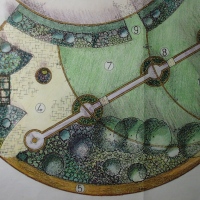Quamash, the common name for Camassia, is a genus of 5 or 6 species of bulbous perennials native to damp, fertile meadowland in north America. They have large, ovoid bulbs which give rise to narrow, erect, linear leaves at the base. The flowers form in racemes on the top of the otherwise bare stems. These are showy flowers, star or cup shaped in blues, purples and white, appearing in mid- late spring.
The bulbs of the species Camassia quamash were once an important food source for native American indians.
Camassias are great in borders or wildflower meadows and make good cut flowers. They are fully hardy to frost hardy and should be planted in the autumn about 10cm deep in moist but well drained soil in sun or partial shade. The soil should not be allowed to become waterlogged. They should be mulched over winter in areas with persistent frosts.
New plants can be grown from seed, which should be sown in containers in a cold frame as soon as it is ripe. Offsets can be removed in summer when the plants are dormant. There are no major pests or diseases affecting Camassia.
To get the best from Camassia flowers plant them against a background that will allow the pale flowers to stand out: e.g. Berberis thunbergii ‘Rose Glow’ – a good foil because the leaves are purple, splashed pink and white; Photinia x fraseri ‘Red Robin’ – blood-red young leaves; and Choisya ternata (Mexican orange blossom).
In borders, Camassias associate well, in light shade, with forget-me-nots, Dicentra spectabilis (bleeding hearts), Lunaria rediviva, Leucojum aestivum (spring snowflake) and Polygonatum x hybridum (Solomon’s seal), and in sun with early-flowering Geraniums and Aquilegia. If naturalised in a meadow, they look good with buttercups, cowslips and the late-flowering pheasant’s eye (Narcissus poeticus var. recurvus).
I have some purple flowered Camassias here in Old School Garden, planted in a mixed border and close by to an orange Tulip ‘Ballerina’ which flowers at about the same time – the colour combination works really well.
Sources and further information:
Wikipedia
How to grow Camassias
Camssia leichtlinii – RHS
Old School Gardener
If you’ve enjoyed reading this post and others on this blog, why not comment and join others by signing up for automatic updates via email (see side bar, above right ) or through an RSS feed (see top of page)?












